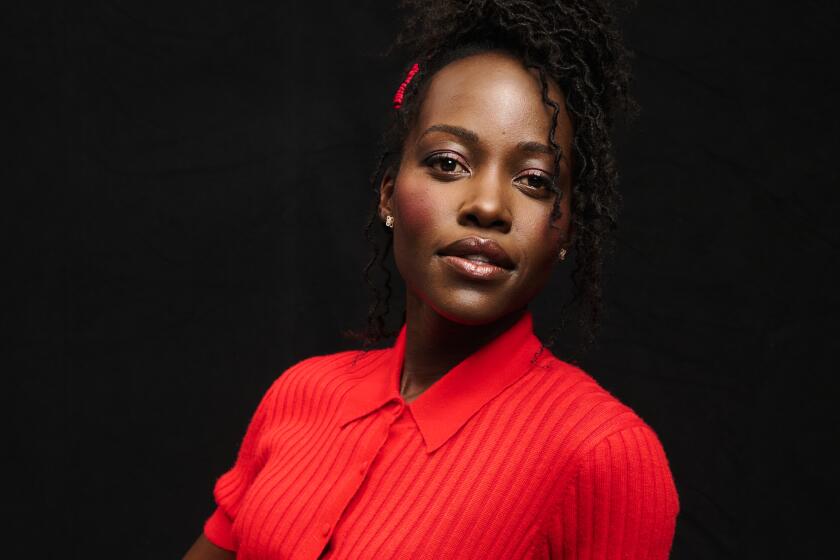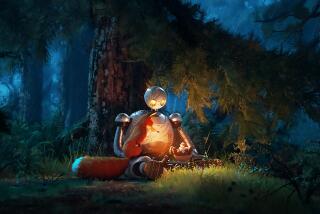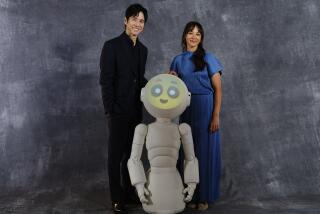
- Share via
As our collective nervousness over AI grows each day, “The Wild Robot” emerges from the woods with a completely different take on a man-made being with the ability to learn.
“I love the messaging of the story, the idea that kindness is a survival tactic,” says star Lupita Nyong’o. “It’s just so pure and sweet and needed.”
In the DreamWorks animated feature, a domestic helper robot, a ROZZUM 7134 (Nyong’o), is lost on a wooded island and activated without human guidance. As the ingeniously designed “Roz” searches for a mission in a vernal bower that looks designed by an Impressionist painter, she learns to communicate with the animal residents and finds purpose in raising an orphaned gosling, Brightbill.
A decade after winning her Oscar, Nyong’o is taking on projects that strike a personal resonance, including the animated sci-fi adventure “The Wild Robot.”
Director Chris Sanders, who adapted the script from Peter Brown’s book, says he was hooked by “the journey of a robot, Roz, who becomes a mother quite by accident, and doesn’t have the programming for that. There’s a lot that I can relate to in that story. I think any parent can relate to that at some point. It’s a mother’s journey, and that’s unusual for an animated film.”
“What resonated for me was being in a totally new environment and having to figure things out,” says Nyong’o, who was born in Mexico and raised in Kenya. “I am an immigrant in America, and there’s an adaptation that I have had to undergo in order to gain my stride as a member of this society. Roz is an alien in this environment and in many ways she’s misunderstood, but she has to learn how to adapt while still remaining true to her core setting, which is kindness.”

The actor’s task is raised to a higher level of difficulty by being deprived of not only a face to convey emotion (apart from two circular lenses for “eyes,” Roz’s head is otherwise featureless) but normal vocal inflections. Her initial dialogue sounds selected from prerecorded samples of a human voice — all Nyong’o’s acting, says Sanders, not an audio trick.
“I was inspired by AI, like the voices of Alexa and Siri and on TikTok and Instagram,” says the Oscar winner (for “12 Years a Slave”). “What I extrapolated was this sort of relentless optimism that comes across in their voice. There’s nothing ever wrong and everything is solvable.”
The director says, “We called it an ‘engineered optimism.’ You hear in the very first bit when Roz wakes up; I liken it to somebody coming to a party and feeling a little bit stressed and saying [too brightly], ‘Hi, my name’s Chris.’ ”
Nyong’o leaned on her theatrical training for the necessary technique and worked with a coach to delineate the vocal stages of Roz’s emotional evolution, eventually landing at story’s end on her warm, natural sound that drew Sanders to her in the first place. With those inner gears finely tuned, the filmmakers sought a unique visual environment, a throwback artistically and a step forward technologically — one that felt human.
It doesn’t hit you over the head with climate catastrophe. But it makes you want to protect the world.
Production designer Raymond Zibach says the brushstroked look of “Wild Robot” is “very naturalistic in that it’s like sloppy nature painting. Oil pastels are kind of Impressionistic. It’s straight-up painting, but loose.” He explains that three-dimensional CG modeling creates very precise geometry onscreen. “We didn’t want that. We developed this tool called ‘Doodle’ — as you draw, and depending on your pen pressure, it makes the volume thinner or thicker. … The technology has really leapt pretty far in the artist-friendly direction. How do we maintain the soft edges of a brushstroke? All that stuff had to be engineered into our pipeline in order to get that final look.”
All of which adorns what is, at the center, a parable about parenting — how it changes the parent, how the parent must learn to let go. You know, all that stuff that won’t make grown-ups weep at all.
Nyong’o says, “When we were recording when Roz is preparing Brightbill for the migration, it dawned on me that what my parents were doing in raising me was preparing me to leave. So I called my mom and said, ‘Thank you so much for being brave enough to let me go,’ because they let me go at age 16, sending me to Mexico to learn Spanish. I thanked her for being courageous and trusting that she’d instilled in me the tools, the qualities, the values that would allow me to thrive out there and come back.
“Roz, in [the migration scene], was my mother at the airport, putting me on a flight by myself. I was so absorbed by my own fears, my own excitement about what lay ahead for me, that I wasn’t thinking about what fears she was having and what preoccupations she was having in letting me go. And she did not reveal it to me, just like Roz.”













